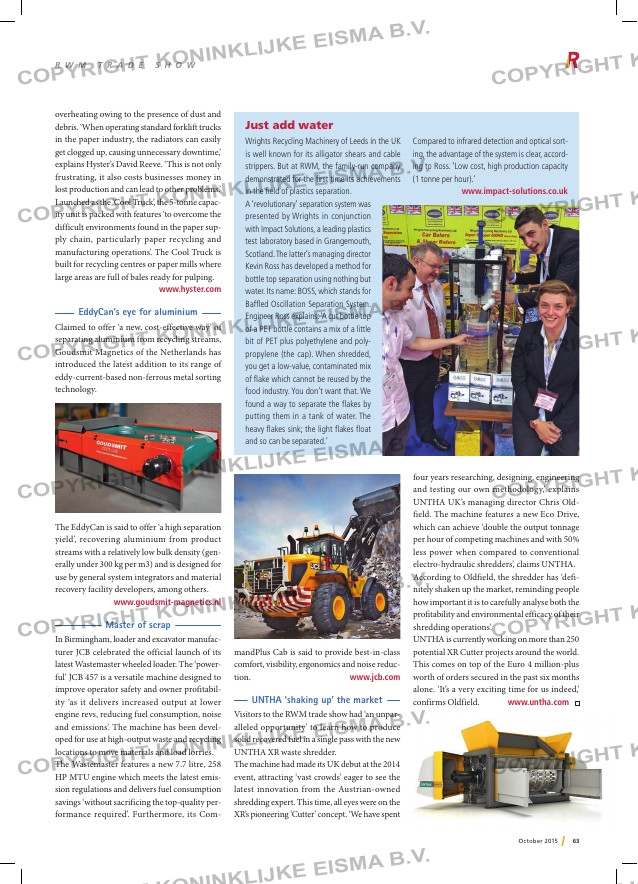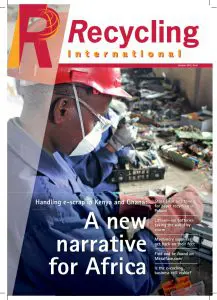Page 65 from: October 2015

63October 2015
R W M T R A D E S H O W
overheating owing to the presence of dust and
debris. ‘When operating standard forklift trucks
in the paper industry, the radiators can easily
get clogged up, causing unnecessary downtime,’
explains Hyster’s David Reeve. ‘This is not only
frustrating, it also costs businesses money in
lost production and can lead to other problems.’
Launched as the ‘Cool Truck’, the 5-tonne capac-
ity unit is packed with features ‘to overcome the
difficult environments found in the paper sup-
ply chain, particularly paper recycling and
manufacturing operations’. The Cool Truck is
built for recycling centres or paper mills where
large areas are full of bales ready for pulping.
www.hyster.com
EddyCan’s eye for aluminium
Claimed to offer ‘a new, cost-effective way’ of
separating aluminium from recycling streams,
Goudsmit Magnetics of the Netherlands has
introduced the latest addition to its range of
eddy-current-based non-ferrous metal sorting
technology.
The EddyCan is said to offer ‘a high separation
yield’, recovering aluminium from product
streams with a relatively low bulk density (gen-
erally under 300 kg per m3) and is designed for
use by general system integrators and material
recovery facility developers, among others.
www.goudsmit-magnetics.nl
Master of scrap
In Birmingham, loader and excavator manufac-
turer JCB celebrated the official launch of its
latest Wastemaster wheeled loader. The ‘power-
ful’ JCB 457 is a versatile machine designed to
improve operator safety and owner profitabil-
ity ‘as it delivers increased output at lower
engine revs, reducing fuel consumption, noise
and emissions’. The machine has been devel-
oped for use at high-output waste and recycling
locations to move materials and load lorries.
The Wastemaster features a new 7.7 litre, 258
HP MTU engine which meets the latest emis-
sion regulations and delivers fuel consumption
savings ‘without sacrificing the top-quality per-
formance required’. Furthermore, its Com-
mandPlus Cab is said to provide best-in-class
comfort, visibility, ergonomics and noise reduc-
tion. www.jcb.com
UNTHA ‘shaking up’ the market
Visitors to the RWM trade show had ‘an unpar-
alleled opportunity’ to learn how to produce
solid recovered fuel in a single pass with the new
UNTHA XR waste shredder.
The machine had made its UK debut at the 2014
event, attracting ‘vast crowds’ eager to see the
latest innovation from the Austrian-owned
shredding expert. This time, all eyes were on the
XR’s pioneering ‘Cutter’ concept. ‘We have spent
four years researching, designing, engineering
and testing our own methodology,’ explains
UNTHA UK’s managing director Chris Old-
field. The machine features a new Eco Drive,
which can achieve ‘double the output tonnage
per hour of competing machines and with 50%
less power when compared to conventional
electro-hydraulic shredders’, claims UNTHA.
According to Oldfield, the shredder has ‘defi-
nitely shaken up the market, reminding people
how important it is to carefully analyse both the
profitability and environmental efficacy of their
shredding operations’.
UNTHA is currently working on more than 250
potential XR Cutter projects around the world.
This comes on top of the Euro 4 million-plus
worth of orders secured in the past six months
alone. ‘It’s a very exciting time for us indeed,’
confirms Oldfield. www.untha.com
Just add water
Wrights Recycling Machinery of Leeds in the UK
is well known for its alligator shears and cable
strippers. But at RWM, the family-run company
demonstrated for the first time its achievements
in the field of plastics separation.
A ‘revolutionary’ separation system was
presented by Wrights in conjunction
with Impact Solutions, a leading plastics
test laboratory based in Grangemouth,
Scotland. The latter’s managing director
Kevin Ross has developed a method for
bottle top separation using nothing but
water. Its name: BOSS, which stands for
Baffled Oscillation Separation System.
Engineer Ross explains: ‘A cut bottle top
of a PET bottle contains a mix of a little
bit of PET plus polyethylene and poly-
propylene (the cap). When shredded,
you get a low-value, contaminated mix
of flake which cannot be reused by the
food industry. You don’t want that. We
found a way to separate the flakes by
putting them in a tank of water. The
heavy flakes sink; the light flakes float
and so can be separated.’
Compared to infrared detection and optical sort-
ing, the advantage of the system is clear, accord-
ing to Ross. ‘Low cost, high production capacity
(1 tonne per hour).’
www.impact-solutions.co.uk



